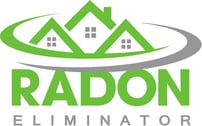Radon FAQ's
What is radon?
Radon is an odorless, colorless, and tasteless, naturally occurring radioactive gas in the air you breathe and the water you use to drink, bathe, and cook. At high levels, it is a serious health hazard.
How does radon get into my home?
Radon gas seeps into your home through the soil, dirt crawlspaces, cracks in the foundation and walls, floor drains, pipes, and sump pumps.
If I have a new home with no cracks or other openings, why should I test for radon?
As a gas, radon seeps through tiny cracks that you might not even see and can even penetrate concrete directly. It can get into finished or unfinished basements and new homes as well as old ones. You won’t know if it’s in your home unless you do a radon test with Radon Eliminator.
The builder says my new home is radon-resistant, so I can’t have radon, right?
Even if you have purchased a home with Radon Resistant New Construction, unless you, the builder, or a home inspector tested your new home for radon, that’s not necessarily so. Although the name Radon Resistant New Construction implies that the home resists radon, RRNC simply is the installation of radon system pipes without a radon mitigation fan. Without the fan, the home is “radon system ready” but not resistant to radon entry, you need a fan installed by a professional to pump the radon gas from underneath your house out.
Is there really any proof that radon causes lung cancer?
The National Cancer Institute says that radon is associated with up to 22,000 lung cancer deaths each year. Epidemiological studies have shown compelling evidence that radon is the number one cause of lung cancer in nonsmokers, and smokers exposed to high radon levels are 10 times more likely to get lung cancer.
How does radon cause cancer?
Radon decays quickly, giving off tiny radioactive particles. When these particles are inhaled as you breathe normally, they begin to damage the cells that line the lung. Long-term radon exposure can lead to lung cancer.
How can people know if they have an elevated level of radon in their homes?
Testing is the only way to know if your home has elevated radon levels. Indoor radon levels are affected by the soil composition under and around the house. Homes directly next to each other can have drastically different indoor radon levels, making a neighbor’s test result in a poor predictor of your homes radon risk.
Our detectors measure continuous radon levels for 2 days. They are an accurate predictor of what your current exposure levels are.
The U.S. Environmental Protection Agency (EPA) recommends taking action to reduce radon in homes with high radon levels. Many scientists estimate that lung cancer deaths could be reduced by 2 to 4 percent, or about 5,000 deaths, by lowering radon levels in homes at or exceeding the EPA’s action level.
The EPA has more information about residential radon exposure and what people can do about it in the Consumer’s Guide to Radon Reduction.
What if I need more information?
Read the National Radon Program Services
What is the best way to contact Radon Eliminator?
Contact Radon Eliminator at 855-Kill Radon or 866-Kill Radon.





